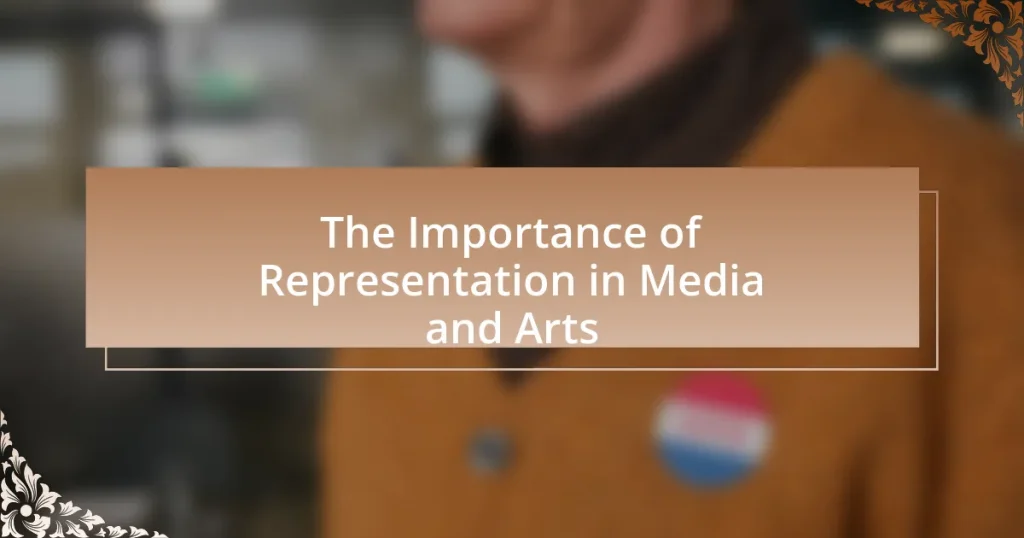Representation in media and arts is essential for shaping societal perceptions and cultural narratives, as it fosters empathy and reduces stereotypes. The article explores the significance of diverse representation, its historical contexts, and its impact on marginalized communities, highlighting how accurate portrayals can influence identity formation and promote social change. It also addresses the challenges faced in achieving equitable representation, the role of technology, and the importance of diversity initiatives in shaping future trends. Practical steps for individuals to support representation in media and arts are also discussed, emphasizing the need for inclusive practices and advocacy.

What is the Importance of Representation in Media and Arts?
Representation in media and arts is crucial because it shapes societal perceptions and influences cultural narratives. Diverse representation allows for a broader understanding of different identities, experiences, and perspectives, fostering empathy and reducing stereotypes. Studies, such as the 2019 report by the Annenberg Inclusion Initiative, highlight that films with diverse casts perform better at the box office, indicating that audiences value representation. Furthermore, representation in media can empower marginalized communities by validating their experiences and promoting social change, as seen in movements sparked by films and shows that highlight underrepresented voices.
Why is representation crucial in media and arts?
Representation is crucial in media and arts because it ensures diverse voices and perspectives are visible, fostering inclusivity and understanding. When various groups see themselves reflected in media, it validates their experiences and promotes social cohesion. Studies show that representation can influence societal attitudes; for instance, a report by the Geena Davis Institute on Gender in Media found that films with diverse casts lead to more positive perceptions of underrepresented groups. This highlights the role of media in shaping cultural narratives and combating stereotypes, making representation essential for a balanced and equitable society.
What are the historical contexts of representation in media and arts?
The historical contexts of representation in media and arts encompass various social, political, and cultural movements that have influenced how different groups are depicted. For instance, the suffrage movement in the early 20th century led to increased visibility of women’s issues in literature and film, while the civil rights movement in the 1960s prompted a reevaluation of racial representation in media. Additionally, the LGBTQ+ rights movement has significantly shaped representation since the late 20th century, challenging stereotypes and advocating for authentic portrayals. These contexts illustrate how societal changes directly impact the narratives and images presented in media and arts, reflecting broader struggles for equality and recognition.
How does representation influence societal perceptions?
Representation significantly influences societal perceptions by shaping how individuals and groups are viewed and understood within a culture. When diverse identities are accurately portrayed in media and arts, it fosters empathy and understanding, leading to more inclusive societal attitudes. For instance, studies have shown that increased representation of marginalized communities in film and television correlates with a reduction in stereotypes and biases, as seen in the research conducted by the Geena Davis Institute on Gender in Media, which found that female characters in leading roles can positively impact young girls’ self-esteem and aspirations. Thus, representation not only reflects societal values but actively contributes to the formation of those values by influencing public perception and behavior.
What forms of representation exist in media and arts?
Forms of representation in media and arts include visual representation, narrative representation, and performative representation. Visual representation encompasses the use of images, symbols, and colors to convey meaning, as seen in paintings, photography, and film. Narrative representation involves storytelling techniques that shape how characters and events are portrayed, influencing audience perception, as demonstrated in literature and screenwriting. Performative representation refers to the enactment of roles and identities in theater, dance, and other live performances, which can challenge or reinforce societal norms. Each form plays a crucial role in shaping cultural narratives and influencing public discourse.
What are the different types of representation in visual arts?
The different types of representation in visual arts include realistic representation, abstract representation, symbolic representation, and conceptual representation. Realistic representation aims to depict subjects as they appear in the real world, often focusing on detail and accuracy, as seen in works by artists like Leonardo da Vinci. Abstract representation, on the other hand, distorts or simplifies forms to convey emotions or ideas rather than realistic depictions, exemplified by artists such as Wassily Kandinsky. Symbolic representation uses symbols to convey deeper meanings or concepts, often found in religious or cultural artworks, while conceptual representation emphasizes the idea behind the artwork rather than its visual form, as demonstrated in movements like conceptual art. Each type serves distinct purposes and communicates different messages within the realm of visual arts.
How is representation manifested in film and television?
Representation in film and television is manifested through the portrayal of diverse characters, narratives, and perspectives that reflect the complexities of society. This includes the inclusion of various ethnicities, genders, sexual orientations, and abilities, which allows for a more authentic depiction of real-world experiences. For instance, studies show that films with diverse casts, such as “Black Panther,” not only achieve critical acclaim but also perform well at the box office, indicating that audiences resonate with varied representation. Furthermore, the representation of marginalized groups can challenge stereotypes and promote social change, as seen in television series like “Pose,” which highlights the lives of transgender individuals and LGBTQ+ communities.
How does representation impact marginalized communities?
Representation significantly impacts marginalized communities by shaping their visibility, identity, and social narratives. When marginalized groups are accurately represented in media and arts, it fosters a sense of belonging and validation, which can enhance self-esteem and community cohesion. For instance, studies show that diverse representation in film and television can lead to increased empathy and understanding among broader audiences, as seen in the success of films like “Black Panther,” which highlighted African culture and narratives, resulting in a reported 50% increase in positive perceptions of Black culture among viewers. Furthermore, representation can influence policy and social change; for example, the portrayal of LGBTQ+ characters in mainstream media has been linked to greater acceptance and legal advancements for LGBTQ+ rights. Thus, representation not only affects individual and community identity but also plays a crucial role in societal attitudes and systemic change.
What role does representation play in identity formation?
Representation plays a crucial role in identity formation by providing individuals with visible models of self and community. When people see themselves reflected in media and arts, it validates their experiences and fosters a sense of belonging. Research indicates that diverse representation can enhance self-esteem and influence personal identity, as individuals often draw inspiration from characters and narratives that resonate with their own lives. For example, a study published in the Journal of Communication found that exposure to positive representations of marginalized groups can lead to improved self-identity and social acceptance among those groups. Thus, representation not only shapes individual identity but also impacts broader societal perceptions and norms.
How can representation in media and arts promote social change?
Representation in media and arts can promote social change by providing visibility to marginalized groups, thereby fostering empathy and understanding among broader audiences. When diverse voices and experiences are depicted, they challenge stereotypes and encourage dialogue about social issues. For instance, the film “Moonlight,” which portrays the struggles of a Black gay man, won the Academy Award for Best Picture in 2017, highlighting the importance of representation in mainstream media. This visibility can lead to increased awareness and advocacy for social justice, as seen in movements like #MeToo and Black Lives Matter, which gained momentum through media representation.
What are the challenges to achieving representation in media and arts?
Achieving representation in media and arts faces several challenges, including systemic bias, lack of access, and financial constraints. Systemic bias manifests in the predominance of certain narratives and perspectives, often sidelining marginalized voices. For instance, a 2020 study by the Annenberg Inclusion Initiative found that only 31.4% of film directors were women, highlighting gender disparity in leadership roles. Lack of access to resources and networks further exacerbates this issue, as underrepresented groups often struggle to secure funding or distribution for their projects. Financial constraints also limit opportunities for diverse storytelling, as projects that do not align with mainstream expectations may receive less investment. These factors collectively hinder the progress toward equitable representation in the media and arts landscape.
What barriers exist for underrepresented groups in the industry?
Underrepresented groups in the industry face several barriers, including systemic discrimination, lack of access to networks, and insufficient representation in decision-making roles. Systemic discrimination manifests through biased hiring practices and workplace cultures that favor majority groups, limiting opportunities for diverse talent. Additionally, underrepresented individuals often lack access to influential networks that can provide mentorship and career advancement, further hindering their progress. Research from the Annenberg Inclusion Initiative highlights that only 17% of film directors are women and people of color, illustrating the significant underrepresentation in key creative roles. This lack of representation in leadership positions perpetuates a cycle where the perspectives and stories of underrepresented groups are overlooked, reinforcing existing disparities in the industry.
How do stereotypes affect representation in media and arts?
Stereotypes significantly distort representation in media and arts by perpetuating oversimplified and often inaccurate portrayals of individuals and groups. These misrepresentations can lead to a lack of diversity and authenticity in storytelling, as seen in film and television, where characters are frequently reduced to one-dimensional roles based on race, gender, or socioeconomic status. For example, a study by the Geena Davis Institute on Gender in Media found that female characters are often depicted in stereotypical roles, which limits the range of narratives available and reinforces societal biases. This not only affects audience perceptions but also influences the opportunities available for marginalized groups in creative industries, thereby perpetuating a cycle of exclusion and misrepresentation.
How can we improve representation in media and arts?
To improve representation in media and arts, it is essential to actively include diverse voices and perspectives in the creation process. This can be achieved by hiring individuals from underrepresented communities in key roles such as writers, directors, and producers, which has been shown to lead to more authentic storytelling. For instance, a study by the Annenberg Inclusion Initiative found that films with diverse directors are more likely to feature diverse casts, highlighting the importance of representation behind the camera. Additionally, implementing policies that promote equity in funding and support for minority artists can further enhance visibility and opportunities in the industry.
What strategies can creators use to enhance representation?
Creators can enhance representation by actively including diverse voices and perspectives in their work. This can be achieved through collaboration with individuals from underrepresented communities, ensuring authentic storytelling that reflects their experiences. Research shows that media representation can significantly influence societal perceptions; for instance, a study by the Geena Davis Institute on Gender in Media found that increased representation of women in film leads to greater acceptance of female leadership roles in society. Additionally, creators can prioritize inclusive casting and character development, which fosters relatability and connection among audiences. By implementing these strategies, creators not only enrich their narratives but also contribute to a more equitable media landscape.
How can audiences advocate for better representation?
Audiences can advocate for better representation by actively supporting diverse content and creators in media and arts. This can be achieved through various actions such as promoting inclusive films, books, and art that reflect a wide range of experiences and identities. Research indicates that diverse representation not only enhances storytelling but also leads to increased audience engagement; for example, a study by the USC Annenberg Inclusion Initiative found that films with diverse casts perform better at the box office. By voicing their preferences on social media, participating in campaigns, and attending events that celebrate underrepresented voices, audiences can influence industry standards and demand more equitable representation.
What are the future trends in representation in media and arts?
Future trends in representation in media and arts include increased diversity, intersectionality, and the use of technology to amplify underrepresented voices. As audiences demand more authentic narratives, creators are focusing on inclusive storytelling that reflects a broader spectrum of identities, including race, gender, sexuality, and disability. For instance, the rise of streaming platforms has led to a surge in content that features diverse casts and stories, as seen in series like “Pose” and “The Queen’s Gambit,” which highlight marginalized experiences. Additionally, advancements in virtual reality and augmented reality are providing new avenues for immersive storytelling, allowing creators to engage audiences in innovative ways that prioritize representation.
How is technology influencing representation in the arts?
Technology is significantly influencing representation in the arts by enabling diverse voices and perspectives to be amplified through various digital platforms. The rise of social media, streaming services, and digital art tools allows artists from underrepresented communities to share their work globally, thus challenging traditional narratives and promoting inclusivity. For instance, platforms like Instagram and TikTok have democratized art distribution, allowing creators to reach audiences without the need for traditional gatekeepers such as galleries or publishers. This shift has led to a broader representation of cultures, identities, and experiences in artistic expressions, as evidenced by the increasing visibility of artists from marginalized backgrounds in mainstream media.
What role will diversity initiatives play in shaping the future of representation?
Diversity initiatives will play a crucial role in shaping the future of representation by promoting inclusivity and ensuring that various voices and perspectives are reflected in media and arts. These initiatives aim to dismantle systemic barriers that have historically marginalized underrepresented groups, thereby fostering a more equitable landscape. For instance, studies have shown that diverse representation in film and television leads to increased audience engagement and broader cultural understanding, as evidenced by the success of films like “Black Panther,” which grossed over $1.3 billion globally and highlighted African culture. Furthermore, organizations such as the Geena Davis Institute on Gender in Media report that gender-balanced representation can lead to more relatable content, influencing societal norms and expectations. Thus, diversity initiatives are essential for creating a media environment that accurately reflects the diversity of society, ultimately enriching the cultural narrative.
What practical steps can individuals take to support representation in media and arts?
Individuals can support representation in media and arts by actively seeking out and promoting diverse creators and their works. This includes purchasing and sharing content from underrepresented groups, such as films, books, and art by artists of various ethnicities, genders, and backgrounds. Research indicates that diverse representation in media not only enriches storytelling but also reflects societal realities, as seen in studies showing that films with diverse casts perform better at the box office. Additionally, individuals can advocate for inclusive practices within their communities by participating in discussions, attending events that focus on diversity, and supporting organizations that prioritize representation in their programming.










